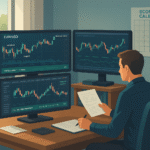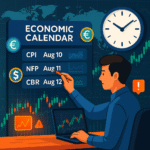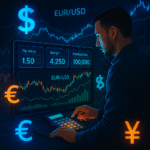When it comes to mastering the markets, technical analysis might be flashy — but fundamental analysis is what builds lasting strategy. In today’s interconnected economy, understanding the why behind market movements is just as important as spotting chart patterns.
This post breaks down what fundamental analysis is, how to apply it, and why it’s crucial in making smarter trading decisions across forex, commodities, and indices.
🔍 What Is Fundamental Analysis?
Fundamental analysis involves evaluating economic, financial, and geopolitical data to determine the real value of an asset — and its potential direction. Unlike technical analysis, which focuses on price charts and indicators, fundamental analysis zooms out to look at broader forces.
Key tools include:
- 🏦 Interest rates
- 📈 Inflation reports
- 🧾 GDP growth
- 📊 Employment data
- 🌎 Geopolitical events
- 💬 Central bank policies
In forex trading, for example, understanding how the U.S. Federal Reserve or the European Central Bank moves interest rates can give insights into currency strength or weakness — before it shows up on a chart.
🧠 Why Traders Need It
Technical setups work well short term, but fundamentals offer long-term context. For instance, a breakout on the USD/JPY chart means little without understanding the Bank of Japan’s negative interest rate stance or Japan’s inflation metrics.
Fundamentals also help with:
- Market timing: Knowing when key events will happen.
- Sentiment analysis: Gauging market emotion based on data releases.
- Risk management: Avoiding trades during high-impact news.
🗓️ Major Economic Indicators to Watch
1. Interest Rate Decisions
Central banks like the Fed or ECB decide on rates — which directly impact currency values. Higher rates attract investors, strengthening that currency.
2. Inflation Reports (CPI, PPI)
Inflation influences rate decisions. If inflation is too high, central banks often raise rates — bullish for that currency.
3. Employment Data
Non-Farm Payrolls (NFP) in the U.S. is a market-moving report. Strong job numbers suggest economic growth, likely causing currency appreciation.
4. GDP Growth
Gross Domestic Product measures economic health. Rising GDP points to stronger currency demand, as investors seek stable and growing economies.
5. Trade Balance
If a country exports more than it imports, demand for its currency rises — driving prices up.
🌍 Real-World Examples from Recent Years
Let’s look at how fundamental events shaped trading in recent years:
- U.S. Rate Hikes (2022–2024): The Fed raised rates aggressively to combat inflation. Traders who tracked FOMC meetings made strategic trades in USD pairs and gold.
- China’s Export Dip (2023): Weak export data led to lower growth expectations. AUD and NZD — which rely on Chinese demand — saw volatility, giving traders opportunities.
- OPEC Announcements: Changes in oil production quotas affected crude prices and currencies like CAD (heavily tied to oil).
Understanding these forces allowed traders to anticipate market moves before technical patterns confirmed them.
🛠️ How to Use Fundamentals in Your Trading
Here’s how top traders combine analysis with execution:
✅ Step 1: Watch the Economic Calendar
Sites like Forex Factory or Investing.com show upcoming data releases. Mark high-impact events and plan your trades around them.
✅ Step 2: Interpret the Forecast vs. Actual
If inflation was expected at 3.2% and comes in at 4.1% — it’s likely bullish for the currency. The bigger the surprise, the more price movement you’ll see.
✅ Step 3: Factor in Sentiment
A strong jobs report might boost the currency — but if the central bank signals rate cuts, that sentiment changes. Always consider the bigger narrative.
✅ Step 4: Align Technicals with Fundamentals
If fundamentals suggest bullish momentum and charts show a breakout pattern — your trade setup becomes much stronger.
🧩 Combining Fundamental and Technical Analysis
The best traders don’t choose sides — they combine both styles. Here’s how:
- Technical entry + fundamental backing: You see a bullish reversal pattern on GBP/USD, and the Bank of England just signaled rate hikes. Good time to go long.
- Fundamental trend + technical timing: You expect USD strength after hawkish Fed commentary — but wait for confirmation on the chart (e.g., RSI crosses above 50 or MACD turns bullish).
🧠 Developing a Fundamental Edge
To become fundamentally savvy, do this consistently:
- Read central bank statements and economic forecasts.
- Follow economists and analysts on platforms like Twitter or Bloomberg.
- Track the historical impact of reports on currency pairs.
Sites like Trading Economics, ForexLive, and FXStreet are goldmines for traders who want daily updates and expert interpretations.
🔐 Risk and Caution
Trading around news can be volatile. Always:
- Use tight stop-losses.
- Wait for initial spikes to settle before entering.
- Avoid trading during red events if you lack experience.
Fundamentals provide insight, but markets often react irrationally — so prepare for surprise moves and use proper risk management.
🗣️ Final Thoughts: Turn Data Into Decisions
Fundamental analysis helps you stop chasing trades — and start anticipating them. When you understand the economic story behind a currency or asset, you trade with confidence, not guesswork.
At its core, fundamentals teach traders how to interpret the why, not just the what. It’s the difference between seeing a storm — and knowing it’s coming before clouds appear.
Want to teach your audience how to analyze interest rates like a pro or read central bank signals like a Wall Street insider? This post is your starting point. From here, build deeper lessons on macroeconomics, sentiment shifts, and real-world trading scenarios.
Let’s trade smarter — by thinking deeper.




